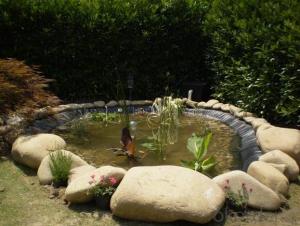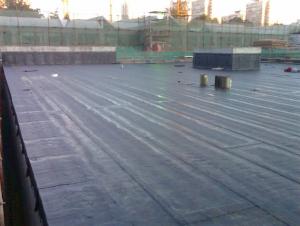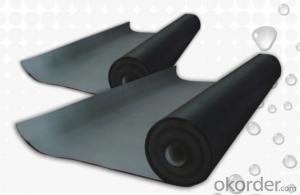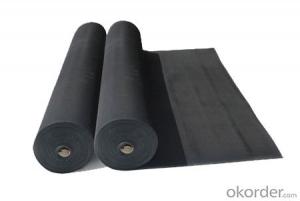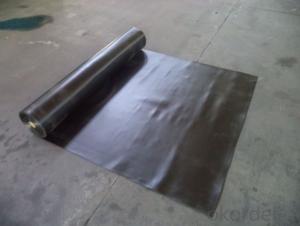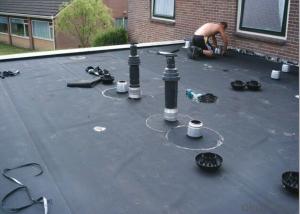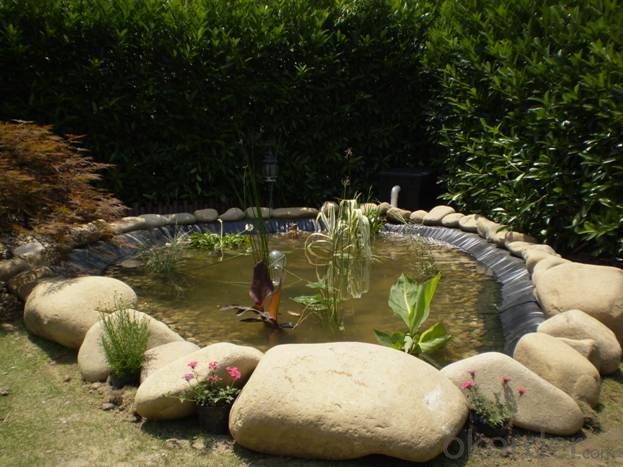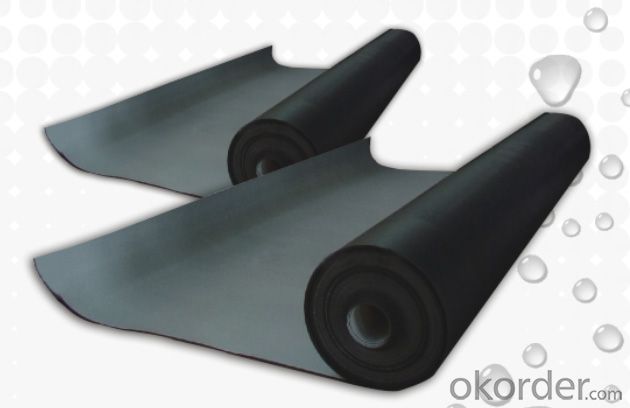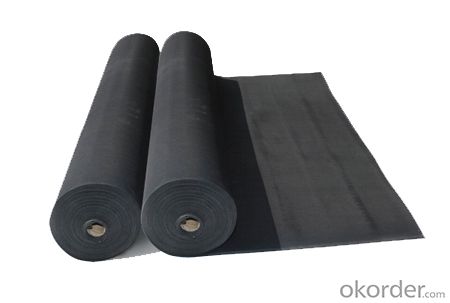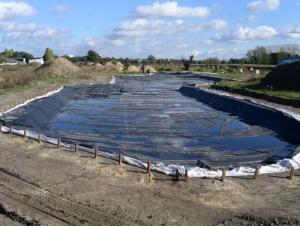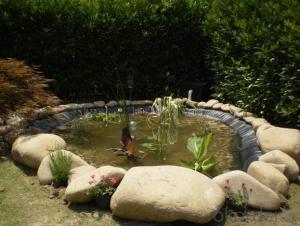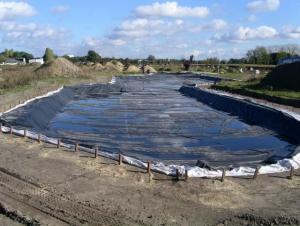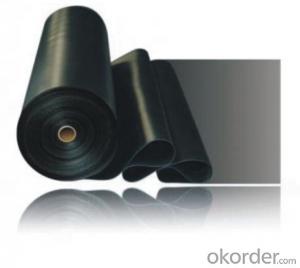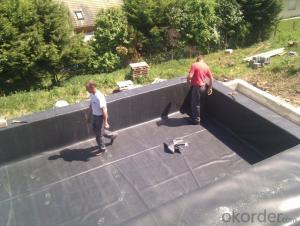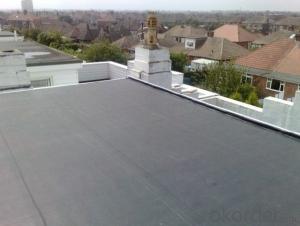EPDM Waterproofing Membrane for Manmade Pond
- Loading Port:
- Shanghai
- Payment Terms:
- TT OR LC
- Min Order Qty:
- 50000 m²
- Supply Capability:
- 5000000 m²/month
OKorder Service Pledge
OKorder Financial Service
You Might Also Like
EPDM Waterproofing Membrane for Manmade Pond
Description Of EPDM Waterproofing Membrane for Manmade Pond:
·Filament polyester filler base sheet material:
·The combination of filament polyester filler base and SBS modified bitumen forms an excellent comprehensive performance and high quality waterproof sheet material;
·High strength waterproof layer and strong water pressure resistance;
·Good performance of breaking resistance, tearing resistance, fatigue resistance, corrosion resistance, mould resistance and weather resistance;
·High tensile strength, high elongation, high adaptive capacity to base shrinkage deformation and fracture;
·Good resistance performance of low and high temperature: It could still work under -20℃ , be applicable to cold and hot regions, especially in chilly region;
·Good workability: It can be constructed by heat fusion method in the four seasons of the whole year and hot-joint is reliable and durable.
·Alkali-free glass fiber filler base sheet material:
·Combination of economical filler base and high performance SBS modified bitumen.
·Higher tensile strength, excellent resistance to high and low temperature.
·Good performance of corrosion resistance, mould resistance, weather resistance and good workability.
·Glass fiber reinforced polyester filler base sheet material:
·It is safe and eco-friendly by using mechanical mounting of construction.
·The product has better dimensional stabiliy.
Main Features of EPDM Waterproofing Membrane for Manmade Pond:
EPDM rubber waterproof membrane can operate in single layer, and is characterized by light weight, ageing resistance, with long service life, great tensile strength and high extension coefficient, which has strong adaptability to shrinkage, cracking and deformation in basic level. It can work well within -40°C to 100 °C and can be constructed with a single layer in ambient temperature. The service life of EPDM rubber waterproof membrane is up to 50 years, which is known as "King of Waterproof".
Specifications of EPDM Waterproofing Membrane for Manmade Pond:
Type | EPDM Rubber Waterproof Membrane | ||
Type | Vulcanized and Weldable | ||
Thickness | 1.2mm | 1.5mm | 2.0mm |
Weight(kg/m2) | 1.54-1.58 | 1.79-1.83 | 2.25-2.29 |
Size | 1.2m (width) * 20m (length)/roll. Weldable type could be 4m wide. | ||
Packing | 24㎡/roll, with plastic bag. (Weldable: 80㎡/roll) | ||
Usage | Roof, basement, pond, Lake, steel structure roofing, underground, tunnel, etc | ||
NO. | Item | Unit | Technical requirement | |
1 | Tolerance on size | Thickness | % | ±10 |
Width | % | ±1 | ||
length | % | Does not allow negative | ||
2 | Fracture tensile strength (normal temperature ) | Mpa | ≥7.5 | |
Fracture tensile strength(60 ℃) | Mpa | ≥2.3 | ||
3 | Breaking elongation,(normal temperature ) | % | ≥450 | |
Breaking elongation,(-20 ℃) | % | ≥200 | ||
4 | Tearing resistance | KN/m | ≥25 | |
5 | Impermeability | * | 0.3Mpa impermeable | |
6 | Bending at low temperature | °C | ≤-40 | |
7 | Elongation and contraction volume at heating | Elongation | mm | ≤2 |
contraction | mm | ≤4 | ||
8 | Hot air aging 80°CX168h | Fracture strength retention | % | ≥80 |
Rate of elongation at break | % | ≥70 | ||
9 | Alkaline (saturated Ca(OH)2 solution normal Temperature x2 168h ) | Fracture strength retention | % | ≥80 |
Rate of elongation at break | % | ≥80 | ||
10 | Ozone aging (40 degree by 168 hours ) | Elongation 40% , 500x10-2 | * | No Crack |
11 | Phytotron aging | Fracture strength retention | % | ≥80 |
Rate of elongation at break | % | ≥70 | ||
Applications of EPDM Waterproofing Membrane for Manmade Pond:
Widely used in roofs, basement, toilet ,swimming pool, and all kinds of industry and civil building waterproofing, reservoir, vivicism, bridge, underground, tunnel and dam waterproofing ,especially to the keystone waterproofing projects which is durability, high corrosion resistance and easy deformation.
Construction Site of EPDM Waterproofing Membrane for Manmade Pond:



IMages of EPDM Waterproofing Membrane for Manmade Pond:




FAQ of EPDM Waterproofing Membrane for Manmade Pond:
1. What are we supplying?
We are specialized in producing Colorful Asphalt Roof Shingle, SBS/APP modified bitumen waterproof membrane, Self adhesive bitumen waterproof membrane, PVC waterproofing membrane, EPDM rubber roofing membrane, Single Component Polyurethane Waterproof Coating, and Spray Polyurea Waterproof Coating
.
2. How Many years experience do we have?
We have been exported to more than 20 countries in the past 15 years.
3. How long do we usually reply your request?
We always reply our customer within 24 hours.
- Q: How does a waterproofing membrane handle water migration through the substrate?
- A waterproofing membrane is designed to prevent water migration through the substrate. It acts as a barrier, preventing water from infiltrating the substrate and causing damage to the structure. The membrane is typically applied to the exterior side of the substrate, creating a watertight seal. To handle water migration, the membrane is typically made from a flexible and durable material such as modified bitumen, PVC, or EPDM. These materials have excellent waterproofing properties and can withstand exposure to water, UV rays, and other environmental factors. The membrane is installed in a way that ensures proper adhesion to the substrate, creating a seamless and continuous barrier. It is often applied in multiple layers to further enhance its effectiveness. The seams and joints are also properly sealed to prevent any potential water leaks. In addition to its primary waterproofing function, the membrane also helps to manage water that may accumulate on the surface. It is designed with a slope or drainage system, directing water away from critical areas and towards appropriate outlets or drains. Overall, a waterproofing membrane is specifically engineered to handle water migration through the substrate by creating a reliable and long-lasting barrier against moisture. It is an essential component in protecting structures from water damage and ensuring their durability and longevity.
- Q: Are waterproofing membranes easy to install?
- Yes, waterproofing membranes are generally easy to install. They come in various forms such as sheets, rolls, or liquid coatings, making them adaptable to different surfaces and applications. The installation process typically involves cleaning and preparing the surface, applying the membrane, and ensuring a proper seal. While some technical knowledge and tools may be required, manufacturers often provide detailed instructions and guidelines for installation, making it easier for both professionals and DIY enthusiasts. Additionally, advancements in technology have led to the development of self-adhesive membranes, which further simplify the installation process. Overall, with the right preparation and following the correct installation procedures, waterproofing membranes can be installed with relative ease.
- Q: Can a waterproofing membrane be used in conjunction with vapor barriers?
- Using both a waterproofing membrane and vapor barriers together is highly recommended to provide thorough protection against moisture. Waterproofing membranes effectively block water from penetrating surfaces like roofs or foundations, while vapor barriers prevent the passage of water vapor. By utilizing both, you can prevent both liquid water and water vapor from causing any harm to a structure. The waterproofing membrane acts as a physical barrier, ensuring that water cannot enter, while the vapor barrier stops moisture buildup within the structure. This combination is especially advantageous in regions with high humidity or areas at risk of water intrusion.
- Q: Can a waterproofing membrane be used in commercial construction?
- Yes, a waterproofing membrane can definitely be used in commercial construction. In fact, it is often a crucial component of the building process. Waterproofing membranes are designed to provide a barrier against moisture, preventing water infiltration and protecting the structure from potential water damage. This is particularly important in commercial buildings where water can cause significant structural issues, such as mold growth, deterioration of materials, and even compromise the integrity of the building's foundation. Waterproofing membranes are commonly used in various areas of commercial construction, including basements, roofs, foundations, and even exterior walls. They are available in different forms, such as sheets, liquid coatings, or spray-applied membranes, offering versatility and adaptability to different construction scenarios. Overall, incorporating a waterproofing membrane in commercial construction projects is a wise investment to ensure the long-term durability and functionality of the building.
- Q: Can a waterproofing membrane be used on metal block surfaces?
- Yes, a waterproofing membrane can be used on metal block surfaces. Waterproofing membranes are designed to create a barrier against water and moisture, and they can be applied to a variety of surfaces, including metal. The membrane will adhere to the metal surface, creating a waterproof layer that helps prevent water infiltration and protect the metal from rusting or corrosion. However, it is important to ensure that the metal surface is clean, dry, and properly prepared before applying the waterproofing membrane to ensure proper adhesion and effectiveness. Additionally, it is recommended to consult with a professional or refer to the manufacturer's instructions for specific guidance on using a waterproofing membrane on metal block surfaces.
- Q: Can waterproofing membranes be used on concrete dams?
- Yes, waterproofing membranes can be used on concrete dams. These membranes are designed to provide a protective barrier against water penetration, helping to prevent leaks and ensure the structural integrity of the dam. By applying the waterproofing membrane to the concrete surface, it can effectively seal the pores and cracks, making the dam more resistant to water damage.
- Q: Can a waterproofing membrane be used in government or municipal projects?
- Yes, a waterproofing membrane can definitely be used in government or municipal projects. In fact, it is often a crucial component in the construction or renovation of various infrastructure projects such as roads, bridges, tunnels, and buildings. Waterproofing membranes help to prevent water infiltration, which can cause damage to the structure and compromise its integrity. By using a waterproofing membrane, government and municipal projects can ensure the longevity and durability of their infrastructure, reducing the need for costly repairs or replacements in the future. Additionally, waterproofing membranes can also contribute to energy efficiency by preventing moisture intrusion, thus reducing the potential for mold growth and improving insulation properties. Overall, the use of a waterproofing membrane in government or municipal projects is highly recommended to enhance the lifespan and functionality of the infrastructure.
- Q: Can a waterproofing membrane be used in crawlspaces or basements?
- Yes, a waterproofing membrane can be used in crawlspaces or basements. In fact, it is highly recommended to use waterproofing membranes in these areas to prevent moisture infiltration and water damage. Crawlspaces and basements are prone to water seepage and high humidity levels, which can lead to mold growth, structural issues, and damage to stored items. A waterproofing membrane acts as a barrier against water intrusion by effectively sealing the foundation walls and floor. It creates a watertight seal that prevents water from seeping into the space, keeping it dry and protected. Additionally, waterproofing membranes also help to control moisture levels by reducing condensation and humidity, thereby creating a healthier and more comfortable environment. Overall, using a waterproofing membrane in crawlspaces or basements is an essential measure to ensure the longevity and integrity of the structure and to safeguard against potential water-related problems.
- Q: Construction Measures for Waterproof Coil in Winter
- 3. Do the seam and the end of the handle. In order to improve the reliability of the winter construction, to prevent the waterproof layer after the hot-melt paving seam with the possibility of seaming, requiring the mouth and the end of the mouth are sealed with sealing material to improve the waterproof impermeability.
- Q: Can waterproofing membranes be used on bridge decks?
- Bridge decks can benefit greatly from the application of waterproofing membranes. Due to the constant exposure to harsh weather conditions like rain, snow, and freeze-thaw cycles, the concrete and steel reinforcement of bridge decks can deteriorate. Waterproofing membranes are specifically designed to counter water infiltration and safeguard the bridge deck against damage caused by moisture. Typically composed of flexible materials like bitumen, PVC, or EPDM rubber, these membranes are directly applied to the surface of the bridge deck. Acting as a barrier, they prevent water from seeping into the concrete and causing corrosion of the reinforcement. They also help minimize crack formation and extend the lifespan of the bridge deck. Furthermore, the effectiveness and durability of waterproofing membranes can be enhanced by combining them with other protective coatings or systems. All in all, the utilization of waterproofing membranes on bridge decks is a widely employed and successful approach to ensure the long-term integrity and functionality of the structure.
Send your message to us
EPDM Waterproofing Membrane for Manmade Pond
- Loading Port:
- Shanghai
- Payment Terms:
- TT OR LC
- Min Order Qty:
- 50000 m²
- Supply Capability:
- 5000000 m²/month
OKorder Service Pledge
OKorder Financial Service
Similar products
Hot products
Hot Searches
Related keywords
